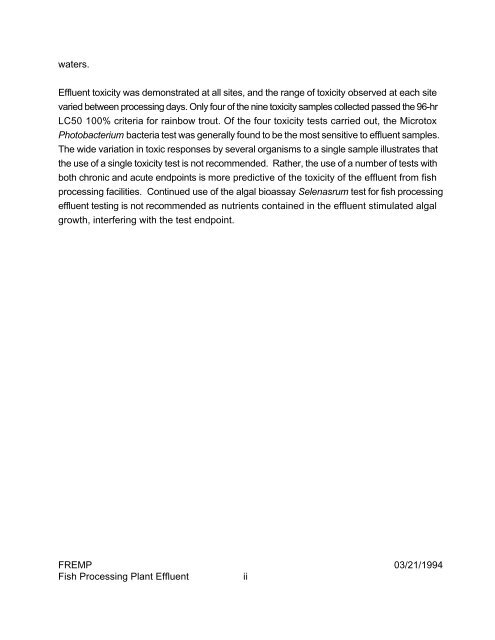- Page 2 and 3: WASTEWATER CHARACTERIZATION OF’ F
- Page 4 and 5: WASTEWATER CHARACTERIZATION OF FISH
- Page 8 and 9: Mr. Chris Coleman (Ocean Fisheries
- Page 10 and 11: 2.9.3 Thawing and Roe Popping . . .
- Page 12 and 13: 6 DISCUSSION OF RESULTS . . . . . .
- Page 14 and 15: LIST OF FIGURES page No Figure 1 Lo
- Page 16 and 17: GENERAL GLOSSARY OF ABBREVIATIONS B
- Page 18 and 19: 1 INTRODUCTION 1.1 Background In Ju
- Page 20 and 21: STRAIT OF \ GEORGIA BURRARD INLET k
- Page 22 and 23: 1.3 Scope The scope of the study wa
- Page 24 and 25: 2 REVIEW OF TYPICAL FISH PROCESSING
- Page 26 and 27: , VESSEL-HOLD WATER PACKERS & RECIR
- Page 28 and 29: Although the iron butcher can be us
- Page 30 and 31: wash water, mixed with guts and blo
- Page 32 and 33: The primary product of herring proc
- Page 34 and 35: 3 REVIEW OF TYPICAL WASTE MANAGEMEN
- Page 36 and 37: \ PROCESS WATER AND OFFAL @t4auoNo
- Page 38 and 39: A more extreme version of offal sep
- Page 40 and 41: fact that the pump rate of two pump
- Page 42 and 43: All yard drains are connected to th
- Page 44 and 45: NAME Bella Coola Fisheries Ltd. OWN
- Page 46 and 47: the facility discharges screened ef
- Page 48 and 49: NAME British Columbia Packers Limit
- Page 50 and 51: contaminated waste stream to the re
- Page 52 and 53: ~ E%!!!ii LEGAL DESCRIPTION: PROPER
- Page 54 and 55: 4.3.2 Description of Processes Grea
- Page 56 and 57:
effluent discharge runs along the w
- Page 58 and 59:
4.4.2 Description of Processes Vess
- Page 60 and 61:
4.5 New West Net Co. Ltd. 4.5.1 Fac
- Page 62 and 63:
I +0 06 + LEGAL DESCRIPTION: LOCATI
- Page 64 and 65:
4.6.1 Facility Description Ocean is
- Page 66 and 67:
LEGAL DESCRIPTION: FRESH & FROZEN P
- Page 68 and 69:
A steady stream of bloody water gen
- Page 70 and 71:
NAME Shearer Seafood Products Ltd.
- Page 72 and 73:
place on-site. The processing build
- Page 74 and 75:
NAME S.M. Products Ltd. OWNER S.M.
- Page 76 and 77:
5 SAMPLE COLLECTION AND TESTING MET
- Page 78 and 79:
(and supplied effluent to the bottl
- Page 80 and 81:
determined for effluent from Ocean,
- Page 82 and 83:
Algal Growth Stimulation/Inhibition
- Page 84 and 85:
In addition to the field QA/QC prog
- Page 86 and 87:
@ SOP manuals: SOP manuals are main
- Page 88 and 89:
Only a small fraction of TS was in
- Page 90 and 91:
Table 2 Summary of Physical/Chemica
- Page 92 and 93:
The lowest ammonia concentrations w
- Page 94 and 95:
Table 3 Summary of Toxicity Test Re
- Page 96 and 97:
6.2.1 Rainbow Trout The endpoints m
- Page 98 and 99:
were more toxic to Ceriodaphnia tha
- Page 100 and 101:
Effluent samples exhibited a wide r
- Page 102 and 103:
ainbow trout (LC50 = 42 % effluent)
- Page 104 and 105:
7 ESTIMATION OF CONTAMINANT LOADING
- Page 106 and 107:
Table 5 presents estimated annual c
- Page 108 and 109:
8 CONCLUSIONS The fish processing a
- Page 110 and 111:
REFERENCES APHA, AWWA and WEF. 1992
- Page 112 and 113:
FREMP Fish Processing Plant Effluen
- Page 114 and 115:
MOELP PERMIT SUMMARY (cent’d) Nam
- Page 116 and 117:
Biochemical — Oxygen Demand (BOD5
- Page 118 and 119:
Total Suspended Solids (TSS) - hist
- Page 120 and 121:
FREMP Fish Processing Plant Effluen
- Page 122 and 123:
B.C.PACKERS Metal (total and dissol
- Page 124 and 125:
; — E ❑ .C 2 c m c c v c z c v
- Page 126 and 127:
— — % 5 1- —
- Page 128 and 129:
OCEAN FISHERIES Metals (total and d
- Page 130 and 131:
FACILITY A RESULTS Ammonia Nitrogen
- Page 132 and 133:
FACILITY C RESULTS Ammonia Nitrogen
- Page 134 and 135:
CONTAMINANT LOADINGS Facility lelia
- Page 136 and 137:
CONTAMINANT LOADINGS (cent’d) Fac
- Page 138 and 139:
CONTAMINANT LOADINGS (cent’d) Sam
- Page 140 and 141:
EVS CONSULTANTS LABORATORY QA/QC PR
- Page 142 and 143:
contamination and maintenance of ap
- Page 144 and 145:
Research Inc. maintains instrument
- Page 146:
Spike - a known amount of analyte i














